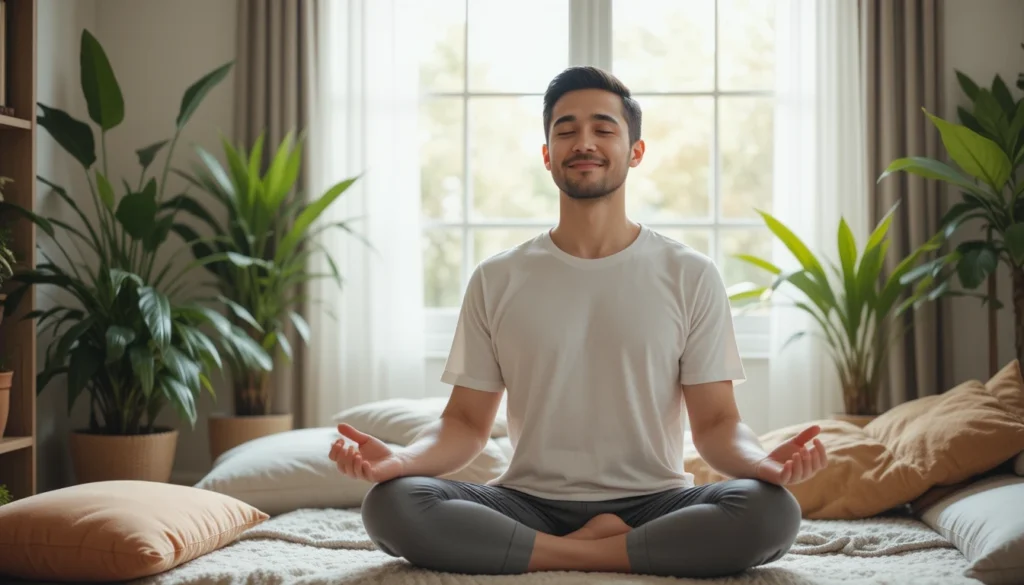Transcendental Meditation vs Mindfulness—Explore the powerful benefits, methods, and key differences between these two popular meditation styles to find your perfect mental escape.
Do you ever feel like your brain just won’t shut off? Between the endless emails, social feeds, and life pressures, modern life is noisy. Really noisy. And in that noise, more people than ever are turning to meditation for peace. But a big question arises: Which type of meditation is right for you?
In the battle of Transcendental Meditation vs Mindfulness, both are popular, both are powerful—but their paths to inner peace are quite different.
This article unpacks both, step by step. Whether you’re a busy professional, a student seeking clarity, or someone just craving calm, you’ll walk away with a clear sense of what works best for you.
Why Meditation Is So Popular Today
Mental health isn’t just a buzzword anymore—it’s a priority. With rising stress, burnout, and the constant pressure to “do more,” people are searching for inner balance. Meditation is no longer niche; it’s now part of our wellness toolkit.
The Wellness Boom
Whether it’s in yoga studios, therapy offices, or wellness apps, meditation is on the rise. CEOs meditate. Students meditate. Even kids are being taught how to pause and breathe.
Yet among the many methods out there, Transcendental Meditation (TM) and Mindfulness have emerged as two of the most effective and accessible options.

What Is Transcendental Meditation (TM)?
A Brief History
Transcendental Meditation was brought to the Western world in the 1950s by Maharishi Mahesh Yogi. It’s based on ancient Indian Vedic traditions and made waves globally when celebrities like The Beatles, Oprah, and David Lynch endorsed it.
How TM Works
TM is a mantra-based meditation. You sit comfortably, close your eyes, and silently repeat a personalized mantra given by a certified teacher. This is done for 15–20 minutes, twice daily.
You’re not concentrating, not focusing on breath, not controlling thoughts. Instead, the mantra gently guides the mind inward—toward deep rest and pure awareness.
The Power of the Mantra
Each mantra is a unique, vibration-based sound—not a word with meaning. This sound helps your mind move beyond surface-level thinking into a “transcendent” state of relaxed alertness.

What Is Mindfulness Meditation?
Its Buddhist Roots
Mindfulness originates from Buddhist traditions, particularly Vipassana practice. But in recent years, it’s been secularized and widely used in clinical psychology, schools, and workplaces.
How Mindfulness Works
At its core, mindfulness means paying attention—on purpose and without judgment—to the present moment. You observe your breath, thoughts, body sensations, or sounds with gentle curiosity.
No mantra. No silence mandate. Just your attention, tuned into now.
Breath and Body Awareness
Most mindfulness practices begin with the breath. Every inhale and exhale becomes a mental anchor, helping bring wandering thoughts back to the present moment.
Transcendental Meditation vs Mindfulness: Key Differences
Here’s a clear table comparing both:
| Feature | Transcendental Meditation (TM) | Mindfulness Meditation |
| Technique | Silent mantra repetition | Observing present moment |
| Effort Level | Effortless | Requires gentle awareness |
| Time Commitment | 20 minutes, twice daily | Flexible, even 5 minutes works |
| Tools Needed | Personalized mantra | None |
| Learning Process | Certified teacher, in-person | Self-guided or with apps/books |
| Spiritual Component | Yes (non-religious) | Often secular |
| Ideal for | Deep relaxation, stress relief | Everyday awareness, emotional balance |
For a more detailed comparison across meditation styles, read our full post on Mindfulness vs Meditation: Key Differences to dive deeper into this topic.
Benefits of Transcendental Meditation
Deep Stress Relief
TM has been shown to reduce cortisol levels (the stress hormone), ease anxiety, and improve sleep quality. Many practitioners say it feels like a mental detox.
Enhanced Brain Function
Research shows that TM improves brain coherence—helping the left and right hemispheres sync up. This leads to more creativity, focus, and even better decision-making.
Scientific Backing
Over 600 peer-reviewed studies have explored TM. According to the American Heart Association, TM can help lower blood pressure and improve heart health.
Benefits of Mindfulness Meditation
Emotional Resilience
Mindfulness enhances emotional regulation, which means you’re less reactive and more present. This is why it’s widely used in therapies like CBT and DBT.
Better Sleep and Relaxation
Mindfulness teaches you to let go of racing thoughts—especially helpful at night when anxiety often peaks.
Cognitive and Neural Benefits
Studies have found that regular mindfulness practice increases gray matter in parts of the brain linked to empathy, memory, and attention.
Which One Is Easier to Learn?
| Aspect | TM | Mindfulness |
| Accessibility | Requires certified teacher | Apps, books, courses available |
| Cost | Often $800–$1200+ (one-time) | Free or low-cost options |
| Setup | Needs structured training | Can start today |
| Time Flexibility | Fixed time slots | Adaptable to your schedule |
Is TM Worth the Price?
TM has a higher upfront cost, but many find its results well worth it. It offers a deeply restful experience that’s hard to replicate.
Mindfulness Is Budget-Friendly
You can start today with free apps like Insight Timer, or dive deeper with paid platforms like Calm or Headspace.
Spiritual vs Secular: What’s Your Vibe?
- TM has spiritual undertones—it’s non-religious, but it talks about consciousness, higher self, and transcendence.
- Mindfulness, in its modern form, is completely secular. That’s why it fits perfectly into schools, hospitals, and offices.
Who Should Try TM?
Ideal For:
- Busy professionals with high stress levels
- People seeking deep relaxation and peace
- Students dealing with performance anxiety
- Those interested in spiritual self-growth
Who Should Try Mindfulness?
Ideal For:
- Beginners new to meditation
- Individuals seeking emotional balance
- Those in therapy or healing from trauma
- Anyone looking for daily mental check-ins
Real-Life Stories
Jason, 42, Lawyer (TM):
“TM saved me from burnout. It’s like someone flipped a switch—20 minutes and I feel totally recharged.”
Maria, 28, Therapist (Mindfulness):
“Mindfulness has changed the way I relate to my clients—and myself. I’m calmer, clearer, and more grounded.”
Can You Combine TM and Mindfulness?
Absolutely. Many practitioners use TM for deeper states of awareness and mindfulness for everyday clarity. You don’t have to choose one over the other—blend them for a full-spectrum mental fitness routine.
Frequently Asked Questions (FAQs)
1. Is Transcendental Meditation a form of mindfulness?
No. TM and mindfulness are distinct. TM uses a mantra to transcend thought; mindfulness involves observing thoughts as they come.
2. Can I learn TM on my own?
No. TM must be taught by a certified teacher who assigns your personal mantra and guides your technique.
3. How long before I see results?
Most people notice positive changes within days or weeks. However, long-term commitment yields the most profound transformation.
4. Which is better for anxiety?
TM often produces quicker calming effects, while mindfulness builds emotional resilience over time. Both are excellent choices.
5. Can children practice these techniques?
Yes! Both TM and mindfulness have age-appropriate programs for children and teens to manage stress and develop focus.
Final Thoughts: Transcendental Meditation vs Mindfulness
Both Transcendental Meditation and Mindfulness offer powerful ways to silence the chaos and find peace within.
- TM is like diving into deep, quiet waters—perfect for when you want profound rest.
- Mindfulness is like turning on a light in a dark room—great for increasing day-to-day awareness and emotional insight.
In the end, it’s not about choosing the “best” meditation—it’s about choosing the one that fits your life.
Or better yet, blend both and enjoy the full range of mental clarity and calm.



